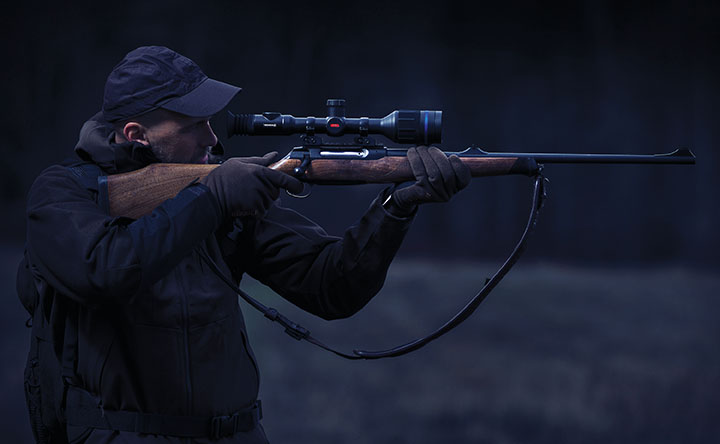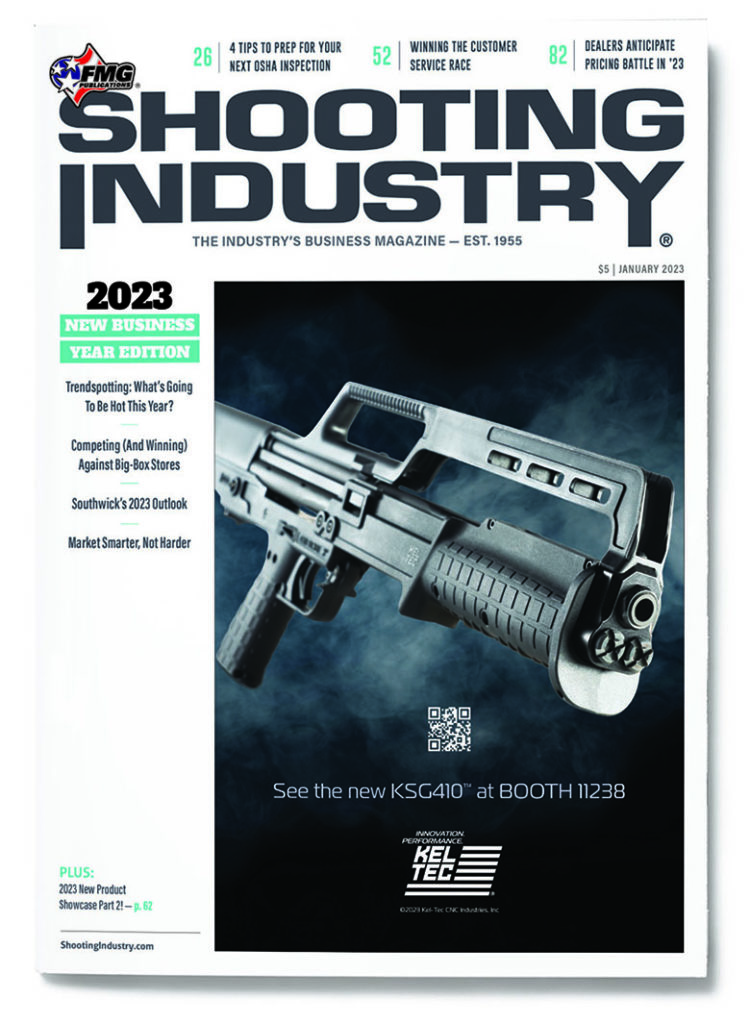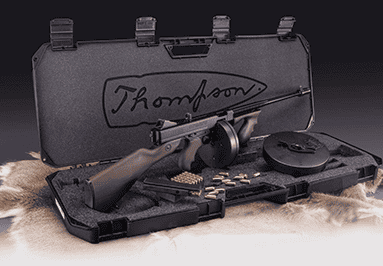Night Sights
Digital Optics Help Hunters Put The Squeeze On Hogs And Coyotes — While Boosting Sales
As more hunters become more proficient at hog and predator hunting, they demand optics that complement their tactics. Thermal and infrared optics are the solution. They can be the most expensive items per unit in a retailer’s inventory, but avid hog and coyote hunters will pay for gear that improves their success and enhances their enjoyment.
As their technology evolves and demand increases, high-quality digital optics are more affordable and more accessible than ever, contends Kevin Reese, senior media relations specialist for Sellmark, which markets the popular Pulsar and Sightmark brands of digital optics.
According to Reese, this represents a potentially lucrative addition to a retailer’s optics department, which can attract new customers and satisfy the needs of existing customers.
“Technology has come a long way,” Reese said. “Just 10–15 years ago, thermal imaging was probably going to run you $15,000 to $20,000, and sometimes $30,000. In my Marine Corps days, thermal existed, but I never saw it. It was more of a mythical creature. Now it’s widely available. And it’s affordable. There’s a number of other brands we compete with on thermal builds. It’s an exciting space. It’s a good time to be in it.”
There’s A Difference
Feral pigs and coyotes are most active at night, but passive day scopes are useless in the dark. Thermal and infrared optics employ electronic imaging to display a target. Infrared scopes route reflected photons through electrodes, and a digital processor reproduces the image on a screen.
A thermal optic emits an infrared ray that returns data to the unit’s internal sensor. The processor interprets this information to create a thermogram, which appears on the device’s screen.
Although they’re categorized as digital optics, infrared and thermal imaging are not the same thing, and they are not interchangeable, Reese said. For starters, “night vision” refers to infrared because it enables a user to see a target’s actual image. A thermal optic displays a target’s heat signature.
Educating a customer about the differences is initially a hurdle for a sales associate, but it also serves as a trust-building exercise, said Josh Hunter, the digital optics specialist at Fort Thompson Sporting Goods in Sherwood, Ark.
“One of the biggest misconceptions is everyone thinks of these as scopes,” Hunter noted. “You have to stop thinking of it as a scope and think of it as a digital camera that happens to have a reticle in it.”
Another important difference is night vision, or infrared, generally shows more detail, allowing a user to positively identify a target. Thermal units generally only reveal something generating heat, but many units don’t have sufficient resolution to show enough detail to identify the source. At a distance, you might not be able to distinguish between a skunk and a house cat, or more important, a feral pig and a cow.
To get better resolution, you have to pay more. Pulsar’s Thermion LRF XP50 Pro, a high-end unit, provides clear resolution for about $6,600, before state and local sales tax.
“A lot of times, people will mislabel thermal imaging as night vision,” Reese said. “They’re not the same things. Thermal will run 24 hours a day. It doesn’t care what time of day it is as long as there are heat signatures out there.”
He continued, “Digital night vision, or generational night vision, is specifically designed to run at nighttime and take light particles and pull those light particles in, to explode them into infinitely more light particles, which are then represented on your screen.”
Because an infrared optic amplifies ambient infrared light, it doesn’t work in darkness. It needs additional light to illuminate a target’s infrared profile. Most infrared units have integral illuminators, but they don’t project sufficient light to illuminate an image at long range. This requires an additional illuminator, usually a large green light.
“If you’re looking at it here under all these fluorescent lights, they’re pumping out a ton of IR, so these optics look amazing!” Hunter said. “But when you get out in the woods, all of a sudden there are no fluorescent lights pumping out a bunch of IR, and you don’t have any image source.”
This brings the customer back to buy an additional illuminator, and he might not be happy about it.
“I tell people this in the store,” Hunter said. “I would say 70% of the time they listen to me. About 30% of the time they’re back looking for a high-end illuminator because their unit just does not have the juice to get them as much distance as they expected.”
“Fact! You definitely get what you pay for! Generally speaking, you’re going to spend about $3,000 for a thermal unit to get the level of image quality that’s going to make you feel comfortable about pulling a trigger.”
Josh Hunter, Digital Optics Specialist
Fort Thompson Sporting Goods • Sherwood, Ark.
A Plug-And-Play Option
A thermal optic, on the other hand, works without an additional light source. It’s truly a plug-and-play device.
Their myriad features make digital optics a gear geek’s dream. They have video capability, so you can video your shots in real time. You can also route the image to a smartphone or stream it.
Sighting in a digital optic is a one-shot process. No longer do you need to “shoot the square” to ensure your turrets move your reticles properly. Instead of turning turrets on a day scope to adjust your reticle to proper windage and elevation, you zero a digital optic through an electronic menu. Aim at the bull’s-eye and shoot. With the reticle still on the bull’s-eye, push buttons to move the reticle digitally to the actual point of impact.
As with all optics, digital optics have introductory, intermediate and advanced tiers, said Steve Lemonov, director of marketing for ATN Corp. Anchoring ATN’s infrared and thermal lineup, respectively, are the X-Sight 4K Pro and the ThOR 4. Tiered price points offer comfortable entry points for all buyers.
The entry-level units are quality products and enable customers to familiarize themselves with the technology. Field experience shows them where they might want to upgrade to improve their performance.
“It’s an affordable opportunity for people testing the waters to use the products and maybe upgrade in six months to a year,” Lemonov added.
You Get What You Pay For
To avoid misconceptions, a retailer should make it clear to a customer a digital optic is one product where price reflects a dramatic difference in image quality.
The average hunter can’t tell the difference between a traditional $200 scope and a $2,000 traditional model. With digital, and especially with thermal, the difference is obvious.
For this reason, Josh Hunter believes, buyers should purchase the best they can afford at the outset.
“Fact: You definitely get what you pay for!” he stated. “Generally speaking, you’re going to spend about $3,000 for a thermal unit to get the level of image quality that’s going to make you feel comfortable about pulling a trigger.”
Fortunately, the price of high-quality digital optics is increasingly affordable. Levi Miller, a sales representative for Sellmark, said Pulsar’s XQ-38 Talion bridges the gap between entry-level and intermediate-level quality for about $2,500.
“It’s the best entry-level thermal we’ve ever come out with,” Miller said. “It comes with everything Pulsar offers: picture mode, eight color palettes, onboard Wi-Fi and a single battery provides about nine hours of operation. It’s super lightweight and a little bit more compact than what people are used to seeing with Pulsar.”
The Talion XP38 also has a 1,500-yard detection range. Comparatively, an ordinary digital night vision scope has a detection range of 300–400 yards. Higher-end models go to 500–600 yards.
1,001 Uses
An upside to digital optic technology is, unlike computers and smartphones, the digital optic you buy today will still be current a year from now. Pulsar and ATN, for example, allow you to download firmware updates to keep your products relevant.
“As older items get phased out, those technologies from the older item are brought into a new item — and it’s at a significantly lower price point than the previous unit,” Hunter shared. “They pull the best parts from a phased-out item and throw it into a new thing, but the new thing is $1,000 less than the old thing. It never stops being relevant. It just kind of gets — I don’t want to use the word ‘recycled’— but to some extent this is kind of what’s happening. You upgrade into something better, but its also significantly less expensive.”
The uses for thermal optics are vast. They’re very helpful in finding dead game, especially in the dark, but their application extends far beyond hunting.
Firefighters use them to search for hidden hotspots in side burning or smoldering structures, and also for victims. Boaters use them at night to detect boats running without lights. Law enforcement personnel use them to find fugitives.
“My wife used it to detect some insulation issues around our windows and doors, so she gave me a little honey-do list,” Reese said. “It has so many different applications outside of hunting.”







